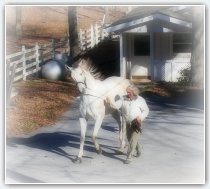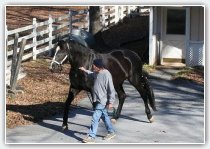Chazot Thoughts VI
Chazot and Manny First walk to new pasture.
Click on image to enlarge
Chazot Thoughts VI
by Jean Luc Cornille
Edited by Susan Hopf
“The discovery of how things work is intrinsically rewarding, and developing the practical applications of discoveries is no less so.”
(Thomas W. Clark)
We moved recently. He told us that we were all moving to Georgia. However, the fear that we could return to our previous life crossed our minds. We were half way reassured when Manchester and I realized that we were moving together. However, the trip was long and while keeping our balance in the trailer, we were reflecting on our current existence verses our previous experiences.
We both agree that the practical application of advances in scientific knowledge is a great part of the considerable difference. It is not that we have never been touched with science. In fact, scientific progress has always been part of our life but mostly at the level of therapies that repair injuries. Instead, he does not use many therapies. He rather applies scientific findings to prevent injuries. He is doing so by developing and educating precisely our physique for the athletic demand of the performance. Manchester pointed out that even if he was already injured when he arrived; his reeducation was about creating a body coordination that reduces the stresses on his stifles. In an instant of deep thought, Manchester added. If I had been educated this way from the beginning, I may never have been lame.
The sign “GEORGIA in your mind” appeared through the trailer’s window. The motto makes us think about our own cerebral evolution. Working with him has considerably extended our mental processing. We are now capable of developing sophisticated body coordination. The synchronizations are far beyond the scope of natural reflexes. We no longer function at the level of pecking order and other instinctive behaviors. He teaches us to orchestrate, efficiently, our physique for the effort and both Manchester and I are participating willingly; Manchester loves the work as he finds soundness and comfort. I do love the partnership as it guides me toward ease, confidence, and great body control.
He often refers to Kenneth Sollitt’s thought, “No one learns to make right decisions without being free to make wrong ones.” This is the fundamental code of our partnership. He selects the gait, the posture, the balance, the body alignment, the gymnastic exercise and lets us process the most efficient solution. Our primary instinct is about natural reflexes, which of course are ill adapted to the demands of modern competitions. Our second inherent reaction is protecting whatever reflex contraction, weaknesses, muscle imbalance, or morphological flaws that are afflicting our bodies. Through discreet insights, he guides our mental research until our brain orchestrates, our physique, optimally for the effort. The process of course includes errors, which he does not treat as errors but rather genuine attempts.
Manchester, who thinks that the Sforza equestrian model is an illustration of his physique, likes referring to Leonardo da Vinci. “Although individuals are endowed genetically with more or less talent in a given area, researchers such as Buzan, Machado, Wenger, and many others have shown that IQ scores can be raised significantly through appropriate training.” (Michael J. Gelb, How to Think Like Leonardo da Vinci.)
I guess we are becoming increasingly intelligent. This must be why he sometime calls me smart ass. The tone of his voice is friendly and I wonder how a guy who is capable of furthering our mental capacities does not know that our brain is not situated in our behind!
Manchester commented; You do not know how lucky you are to do not know about neck posture, “correct aids equal correct movements,” and other simplistic systematizations. The equestrian education is full of these theories. A given neck posture, or hand, or leg action is supposed to stimulate a specific reaction of our body. Of course this is ridiculous but this is a fundamental belief of most equestrian theories. I was lunged with side reins based on the thought that a stable and round neck posture does flex our vertebral column longitudinally. It did not feel that way to me. I have a very thick neck and since the body of my neck cannot compress, I learned to deal with the restriction of the side reins lowering the trunk between the shoulder blades and arching my back.
One day as he was ridding me, he gently adjusted the right rein, placed his right hand above my whither saying, this, my dear is the fifth rein effect. According to the French school, you should displace your body laterally and forward to the left. Even if I have some French blood in my ancestors, the rein effect did not stimulate any reflex even close to the move that he described. I guess, I could, via memory associate such rein effect with forward and lateral displacement of my body to the left but the gesture does not prepare my body, at all, for the move.
Manchester knows about the rein effects. He further commented about similar concepts related to the rider’s legs. You do not know about the ‘spurs attack’ because he does not wear spurs. This is a quite painful action based on the theory that acting with the spurs on our flanks, the rider can increase our hind legs’ engagement. We learn by reflex conditioning the meaning of the spurs, but the touch itself does not muscularly stimulates any hind legs action since the rectus abdominis muscles that the spurs excite, are not directly acting on the hind legs’ engagement. We always have used our brain to compensate for the approximation of the riding and training techniques. However, if our creativity allows us to figure the meaning of a given cue, we do not analyze a performance in terms of optimum efficiency. Instead, our brain protects whatever muscle imbalance, reflex contraction, morphological flaw and even kinematics abnormalities that are afflicting our physique. The novelty of his work is that it is about guiding our brain toward the coordination of our physique precisely adapted to the athletic demand of the performance. For you, this is normal because you have not been trained another way. For me this is a considerable progress.
One day, I came back from a training session and Manchester commented; nice half passes. I asked him what is half pass? Manchester told me, what you just did. I guess, he was focusing on teaching me the body coordination preparing my physique for the effort and did not feel that it was important to tell me the name of the movement. I was working on keeping the proper correlation between lateral bending and transversal rotation of my thoracolumbar spine. The fact is that when I was able to sustain, lateral bending and proper rotation, the longitudinal flexion of my spine was almost systematic and I had no difficulty to move laterally to the left. I guess I am not fully symmetrical since I had to concentrate executing the move to the right. 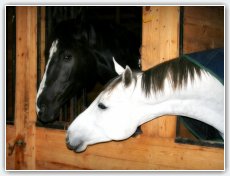 Manchester was now animated. This is exactly where all the difference is. You do not even know the name of the movement but you already know, better than me, how to coordinate efficiently your physique for the effort. I was trained the other way. I was told how half pass is supposed to look and I was expected to figure how to do it right. I had no idea how to coordinate efficiently my physique for the move. I was protecting my arched back and weak stifles. I learned eventually to move sideways while looking in the direction of the movement but I was unable to sustain amplitude and cadence. Both half passes were for me painful and senseless compulsories. Probably due to his background as a gymnast, he does not believe that repeating the movement does educate the body. Instead, he develops and coordinates our physique for the athletic demand of the performance. He did not ask me to execute half pass until he felt that my body coordination was appropriated for the move. He worked for a while on the longitudinal flexion of my vertebral column. One day he asked me for the movement. I obliged but I was a little concerned. At the first step, the memories of pain resurfaced. At the second step I wondered when the pain will strike. At the third step I cannot believe that I was executing half pass pain free. At the fifth step, I was amazed by the feeling of ease. At the tenth step, I was ready to do it again.
Manchester was now animated. This is exactly where all the difference is. You do not even know the name of the movement but you already know, better than me, how to coordinate efficiently your physique for the effort. I was trained the other way. I was told how half pass is supposed to look and I was expected to figure how to do it right. I had no idea how to coordinate efficiently my physique for the move. I was protecting my arched back and weak stifles. I learned eventually to move sideways while looking in the direction of the movement but I was unable to sustain amplitude and cadence. Both half passes were for me painful and senseless compulsories. Probably due to his background as a gymnast, he does not believe that repeating the movement does educate the body. Instead, he develops and coordinates our physique for the athletic demand of the performance. He did not ask me to execute half pass until he felt that my body coordination was appropriated for the move. He worked for a while on the longitudinal flexion of my vertebral column. One day he asked me for the movement. I obliged but I was a little concerned. At the first step, the memories of pain resurfaced. At the second step I wondered when the pain will strike. At the third step I cannot believe that I was executing half pass pain free. At the fifth step, I was amazed by the feeling of ease. At the tenth step, I was ready to do it again.
Quite often he comes into my turnout area and sits next to me as I am taking a nap.  True friendship comes when silence between two peoples is comfortable. I do like these moments of quiet complicity. Sometime we just share our silence. Other times, he is reading a study. This time, it was a small book and I remember one sentence, “Many promising young horses with excellent gaits fail to learn passage and piaff, resulting in years of wasted training. It is probably due to insufficient knowledge of the biokinematics of the collection.” (1)
True friendship comes when silence between two peoples is comfortable. I do like these moments of quiet complicity. Sometime we just share our silence. Other times, he is reading a study. This time, it was a small book and I remember one sentence, “Many promising young horses with excellent gaits fail to learn passage and piaff, resulting in years of wasted training. It is probably due to insufficient knowledge of the biokinematics of the collection.” (1)
Listening to Manchester I can easily understand why talented horses are not capable to express their full potential. I have the unique opportunity to be educated in respect of the most advanced knowledge of our physiology and have a friend that has been previously submitted to traditional beliefs. Even with him guiding my brain toward the coordination of my physique precisely adapted to the effort, I have to try many times and make many errors before I can find the right muscular combination. No wonder if, as talented as they can be, horses are unable to fully express their talent if the sole insights they have are the judging standards.
We do not think in terms of judging standards. Instead, our mind is primarily concerned in protecting our body. Long ago, when we were wild animals, our ancestors owed their survival to their capacity to run faster and further away than their predators. Considering our large size and heavy weight, our ability to sustain speed for a relatively long period of time demanded extreme anatomical adaptations. Down to the fibers composing our muscles, we are designed to produce maximum force with minimum muscular work. This is the way our muscular system is designed to operate and therefore, such is the way our central nervous system and in particular our brain is processing information.
Personally, I do not mind muscle fatigue as long as it is not exhaustion. 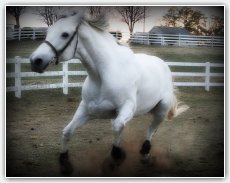 In fact, I do need physical exercise for my energy level and mental sanity. Due to the condition that I inherited from my ancestors, I am very sensitive to pain and pain anticipation. I used to have a problem related to calcium regulation tie up. The condition is known as RER and it caused sharp pain in my back. I reared impulsively as a reaction to aching and nobody on the racetrack ever thought beyond bad behavior.
In fact, I do need physical exercise for my energy level and mental sanity. Due to the condition that I inherited from my ancestors, I am very sensitive to pain and pain anticipation. I used to have a problem related to calcium regulation tie up. The condition is known as RER and it caused sharp pain in my back. I reared impulsively as a reaction to aching and nobody on the racetrack ever thought beyond bad behavior. 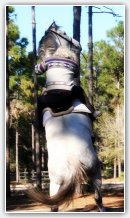 They punished me for my rearing but never explored the thought that there was a reason for my reaction. He told me that Helyn and her friend Elisabeth Gormley, were the one looking into my ancestors’ lines and finding out about the RER condition. Everything after this discovery was like the pieces of a puzzle which gradually lead to the full picture.
They punished me for my rearing but never explored the thought that there was a reason for my reaction. He told me that Helyn and her friend Elisabeth Gormley, were the one looking into my ancestors’ lines and finding out about the RER condition. Everything after this discovery was like the pieces of a puzzle which gradually lead to the full picture.
Once they figured the root cause, they were able to plan the reeducation. On one hand, I hate to think that he is guiding my mind, but on the other hand I am able, through this partnership, to coordinate efficiently my physique for the effort. He knows how I need to organize my muscular system and he lets me explore solutions.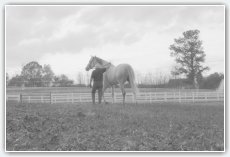 His confidence in me stimulated my self confidence. His leadership encouraged me to explore muscular works that I was previously protecting. I have a very strong will, which gives me the guts to explore into the unknown but also triggers very quickly protective reflex contractions and even aggressiveness.
His confidence in me stimulated my self confidence. His leadership encouraged me to explore muscular works that I was previously protecting. I have a very strong will, which gives me the guts to explore into the unknown but also triggers very quickly protective reflex contractions and even aggressiveness.
Already in 1932, Kleiber wrote, “It is critically important for the horse to limit its investment of metabolic energy in locomotion because the mass-specific metabolic rate is less for large animals than smaller ones.” (2) Our physique is a model of energy saving. At speed for instance, aerobic muscle power only accounts for a small fraction of the mechanical work. The remainder of the work is assumed by elastic strain energy storage and release from associated structures such as tendons, ligaments, intervertebral discs, etc. During collection for example, our back muscles nuance the intensity of their isometric hold in order to maximize the elastic strain energy of their tendons. This subtle muscular work is for a great part orchestrated within our brain. In addition, numerous subconscious activities such as monosynaptic arc reflex, somatic functions related to balance, and others, are involved. The orchestration of the whole network is creating gaits and performances. Not only the voluntary aspect of our body control needs to be directed toward the proper coordination, but subconscious components must not be disrupted by confusing or unnecessary rider actions.
For instance, the shift of the rider’s weight is one of the greatest disturbances that we have to deal with. We are controlling balance through the subtle orchestration of our back muscles, which are situated in mirror image direction. Whatever the rider’s weight is acting back to front or front to back, the shifts hamper our ability to achieve precise coordination. Confusingly, the thought is emphasized in the classical literature. “Undoubtedly any shift of the rider’s weight is important for balancing the horse for controlled movements.” (3) There are numerous examples in the history of riding where the literal meaning of a word does not have the significance that the author had in mind when he used the word. Undoubtedly, great masters had the skill and the subtlety to harmonize their vertebral column movements to the range of motion of their horse’s vertebral column but described their action as shift of their body weight because it was in line with the general consensus. I remember a conversation that he had one day with a friend, “I did the same thing. For a while, I was riding one way and winning in the show ring because I was riding this new way, but I was teaching traditional views because I was not capable to explain it as a teacher”.
The aim of academic equitation has reached its limits. Submitting better horses may have raised equine performances, but at the cost of the horse’s soundness. By contrast, educating better horses to achieve better control of their own physique enhances both, equine athletic performances and the horse’s propensity to remain sound. “You can have neither a greater nor a lesser domination than that over yourself.” (Leonardo da Vinci) 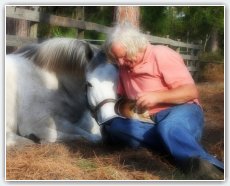
Chazot
References:
(1) (Mikael Holmström Dissertation, Upsalla, 1994)
(2) (Kleiber M. 1932. Body size and metabolism. Hilgardia 6:315-353)
(3)(Estienne Saurel. !964. Pratique de l’ équitation d’ après les maitres français. Flammarion, Paris)
Jean Luc Cornille Copyright©2011


